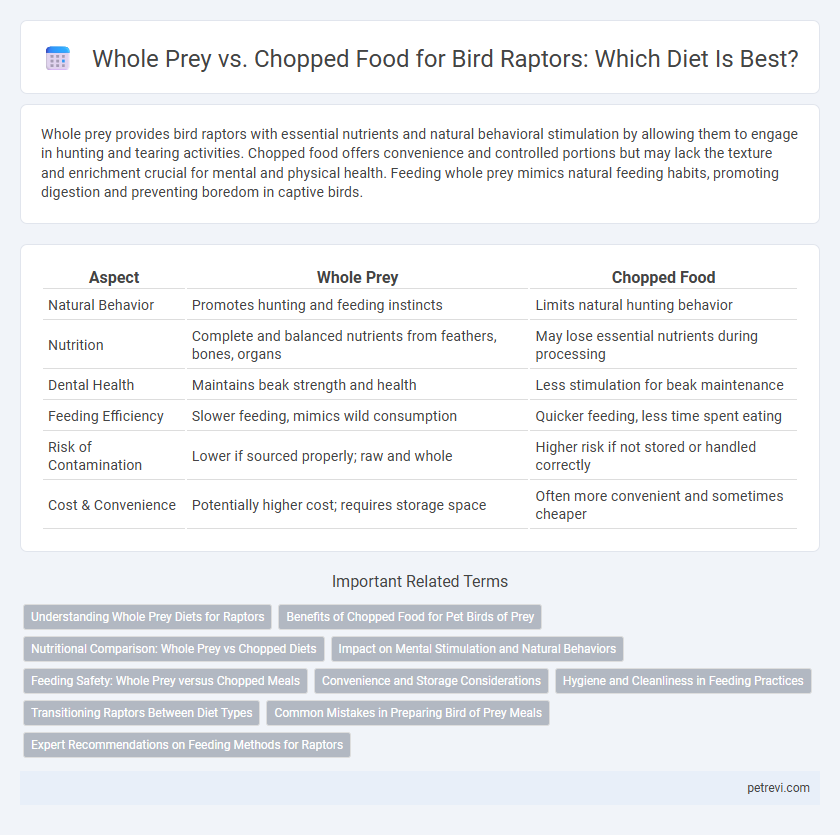Whole prey provides bird raptors with essential nutrients and natural behavioral stimulation by allowing them to engage in hunting and tearing activities. Chopped food offers convenience and controlled portions but may lack the texture and enrichment crucial for mental and physical health. Feeding whole prey mimics natural feeding habits, promoting digestion and preventing boredom in captive birds.
Table of Comparison
| Aspect | Whole Prey | Chopped Food |
|---|---|---|
| Natural Behavior | Promotes hunting and feeding instincts | Limits natural hunting behavior |
| Nutrition | Complete and balanced nutrients from feathers, bones, organs | May lose essential nutrients during processing |
| Dental Health | Maintains beak strength and health | Less stimulation for beak maintenance |
| Feeding Efficiency | Slower feeding, mimics wild consumption | Quicker feeding, less time spent eating |
| Risk of Contamination | Lower if sourced properly; raw and whole | Higher risk if not stored or handled correctly |
| Cost & Convenience | Potentially higher cost; requires storage space | Often more convenient and sometimes cheaper |
Understanding Whole Prey Diets for Raptors
Whole prey diets for raptors mimic their natural feeding behaviors by providing intact animals like mice, chicks, or quail, which support beak and talon maintenance while offering balanced nutrition rich in protein, calcium, and essential fatty acids. Chopped food lacks the chewing and tearing challenges that stimulate natural hunting instincts and can lead to nutritional imbalances if not carefully formulated. Studies show that whole prey enhances digestive health and mental enrichment, promoting physical strength and longevity in captive raptors.
Benefits of Chopped Food for Pet Birds of Prey
Chopped food for pet birds of prey offers enhanced digestion and nutrient absorption by mimicking natural prey textures while reducing the risk of choking. It allows precise portion control, ensuring a balanced diet tailored to individual species and health conditions. This form also facilitates easier feeding for handlers, promoting regular consumption and overall well-being in captive raptors.
Nutritional Comparison: Whole Prey vs Chopped Diets
Whole prey diets provide raptors with essential nutrients such as calcium, vitamins, and amino acids derived from bones, feathers, and organs, ensuring balanced nutrition that mimics natural feeding habits. Chopped diets may lack the structural benefits and certain micronutrients present in whole prey, potentially leading to deficiencies without proper supplementation. Studies show that raptors fed whole prey exhibit better bone health and digestive efficiency compared to those on exclusively chopped food regimens.
Impact on Mental Stimulation and Natural Behaviors
Feeding whole prey to bird raptors enhances mental stimulation by encouraging natural hunting and feeding behaviors, promoting cognitive engagement and physical dexterity. Chopped food, while easier to consume, often diminishes opportunities for problem-solving and reduces enrichment derived from dismembering and manipulating prey. Providing whole prey supports behavioral health by mimicking wild foraging patterns and preventing boredom-related stress.
Feeding Safety: Whole Prey versus Chopped Meals
Feeding safety for raptors significantly improves with whole prey due to the natural structure allowing birds to tear and consume food at their own pace, reducing choking hazards. Chopped meals, while convenient, pose risks such as improper size leading to aspiration or digestive issues without the natural protective benefits of bones and feathers. Whole prey also provides essential behavioral enrichment and promotes healthy feeding instincts critical for raptor well-being.
Convenience and Storage Considerations
Whole prey offers raptor bird owners convenience through longer shelf life and straightforward storage in frozen conditions, reducing frequent thawing needs. Chopped food demands more careful packaging to prevent spoilage, requiring frequent refrigeration or freezable portions to maintain freshness. Efficient storage solutions for whole prey include vacuum-sealed bags and frost-free freezers, optimizing space and preserving nutritional value for extended periods.
Hygiene and Cleanliness in Feeding Practices
Whole prey feeding for bird raptors promotes better hygiene and cleanliness by reducing food contamination and minimizing bacterial growth compared to chopped food. Feeding whole prey mimics natural feeding behaviors, allowing raptors to consume food in a cleaner and more efficient manner. Chopped food can create leftover debris, increasing the risk of mold and pathogens in the feeding area.
Transitioning Raptors Between Diet Types
Transitioning raptors from whole prey to chopped food requires careful attention to nutritional balance and feeding behavior to ensure optimal health. Whole prey maintains natural hunting instincts and supports dental health, while chopped food can simplify digestion and reduce choking risks. Gradual introduction combining both diet types helps raptors adapt without stress or nutritional deficiencies.
Common Mistakes in Preparing Bird of Prey Meals
Common mistakes in preparing whole prey versus chopped food for bird raptors include mishandling nutritional balance, leading to deficiencies or imbalances in calcium and vitamin D essential for bone health. Offering only chopped food can result in reduced natural foraging behavior and inadequate mental stimulation, while whole prey sometimes poses risks of injury or choking if not appropriately sized. Ensuring proper freezing and thawing techniques is crucial to prevent bacterial contamination, which can severely impact raptor health.
Expert Recommendations on Feeding Methods for Raptors
Expert recommendations for feeding raptors emphasize whole prey as the optimal choice, as it closely mimics their natural hunting and feeding behaviors, providing essential nutrients and mental stimulation. Whole prey helps maintain strong beak and talon health by encouraging natural tearing and shredding, while chopped food may lack the texture and challenge needed for these vital functions. Professionals advocate for whole prey feeding to promote overall physical well-being and replicate a raptor's natural dietary intake.
Whole prey vs Chopped food for Bird raptors Infographic

 petrevi.com
petrevi.com